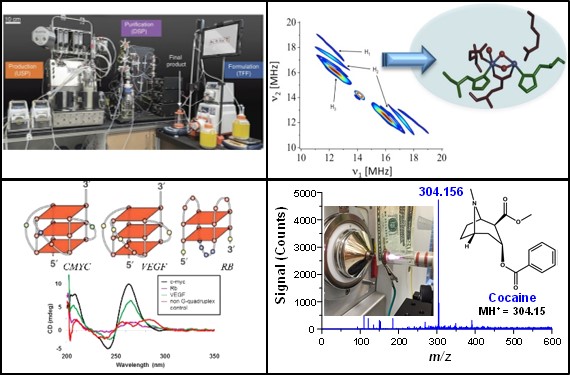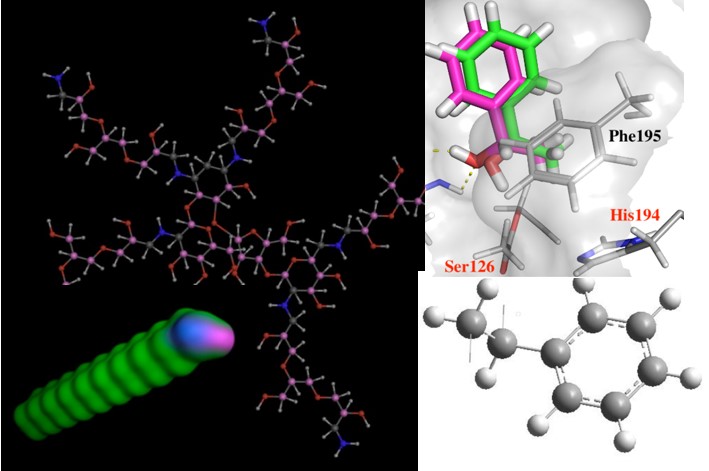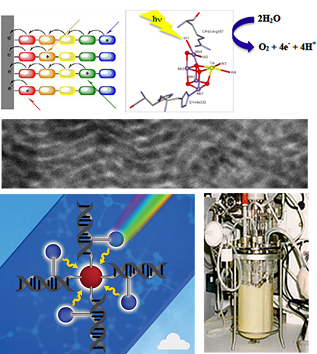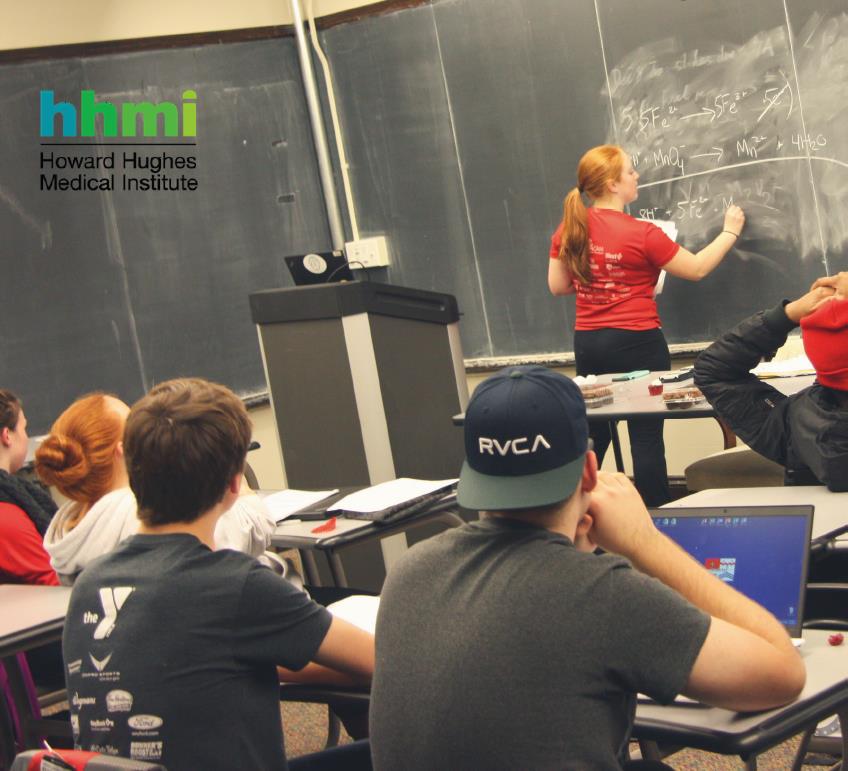Chemistry and Chemical Biology researchers are driving emerging fields of science and technology that lie at the intersection between chemistry and biotechnology, energy sciences, physics, biochemistry, computational methods, and materials science and nanotechnology.

Analytical and Bioanalytical Chemistry
Faculty Researchers:
The disciplines of analytical and bioanalytical chemistry aim to improve/expand methods and/or develop new instrumentation for chemical and biochemical analyses. These new tools and methods are then applied to new or complex chemical problems to provide qualitative (i.e. what is it?) and quantitative (i.e. how much?) information of analytes within a sample, or to probe the behavior of complex molecular systems in areas such as materials, biomaterials, energy, and biology. In the Department of Chemistry and Chemical Biology at RPI, examples of analytical research projects currently being explored include: i) experimental and computational studies of protein-ligand interactions in chromatographic separations (Cramer), ii) the development of multi-frequency, multi-dimensional, and time-resolved nuclear magnetic resonance (NMR) and electron paramagnetic resonance (EPR) spectroscopy methods to study charge-transfer reactions in natural photosynthetic systems (Lakshmi), iii) probing the genome to find aptamers for highly selective capture, recognition, and sensing of biomolecules (McGown), and iv) development of mass spectrometry to enable real-time, on-site analyses of complex samples (Shelley). Often, the analytical research conducted at RPI is utilized across many disciplines of science and technology. For instance, Professors McGown and Shelley are applying their work in capillary electrophoresis and mass spectrometry, respectively, to better understand the chemical origins of life in realistic early-Earth environments as part of the Rensselaer Astrobiology Research and Education (RARE) Center. Because of the diverse applicability of the techniques developed at RPI, researchers in this area work at the interface of chemistry, physics, engineering, biology, geology, and materials science. Related Centers: Rensselaer Astrobiology Research and Education (RARE) Center and Baruch ’60 Center for Biochemical Solar Energy Research

Biophysics, Biochemistry and Chemical Biology
Faculty Researchers:
The Biophysics, Biochemistry and Chemical Biology division of the Chemistry and Chemical Biology department is focused on elucidating the mechanisms of energy conversion and ion transport, capture, detection, folding and stability of proteins, developing enzymatic biosyntheses in vitro and designing functional aptamers as diagnostics and therapeutics. Our faculty are developing advanced spectroscopic (multi-frequency multi-dimensional pulsed EPR, solid-state and solution NMR, visible-NIR, fluorescence, FTIR and rapid kinetics), computational (quantum mechanical, molecular dynamics and bioinformatics), small-angle X-ray scattering, fluctuation microscopy, fluorescence lifetime and PALM/STORM imaging, pressure perturbation calorimetry, protein biochemistry, molecular biology, microbial engineering, affinity capture and detection, nucleic-acid based molecular programming and pressure based mapping techniques. Research projects are focused on the discovery of hyperstable proteins for industrial, agricultural and health-related applications, development of enzymatic syntheses of next-generation therapeutics, biopolymers and materials, synthesis of functional DNA/RNA aptamers, elucidation of the molecular mechanism of biological solar energy conversion and the development of bio-inspired artificial photosynthetic devices for solar fuels production, design of nanostructures for energy harvesting, diagnostics and drug therapies, understanding the mechanisms of ion transport, energy production, cell state transitions and cellular responses to stresses, pressure effects on proteins and protein folding and the structure and dynamics of proteins in disease. Related Centers and Constellations: Baruch ’60 Center for Biochemical Solar Energy Research, Center for Biocatalysis and Bioprocessing, Center for Biotechnology and Interdisciplinary Studies, Biocomputation and Bioinformatics Constellation, Biocatalysis and Metabolic Engineering Constellation, Center for Computational Innovations and Center for Future Energy Systems.

Biotechnology and Biomaterials
Faculty Researchers:
Biotechnology harnesses cellular and biomolecular processes to develop products that help improve our lives and the health of our planet. This includes activities such as genetic engineering as well as cell and tissue culture technologies. Biotechnology is providing breakthrough products to combat debilitating and rare diseases, reduce our environmental footprint, feed the hungry, provide cleaner energy as well as green and sustainable manufacturing processes. Biotech uses processes such as fermentation and biocatalysts such as enzymes and microbes. It is often broken down into three categories: i) health care, ii) agricultural, and ii) industrial. For example, health care biotechnology involves development of biopharmaceuticals whereas industrial biotech focuses on production of commodity chemicals, such as polymers, ethanol, biodiesel, and basic feedstocks. Polymer Biomaterials are derived either from nature or synthesized in the laboratory using a variety of chemical approaches. They may be inert or used to induce a physiological response supportive of the biomaterial's function. Examples of biomaterial applications are scaffolds for cell growth (tissue engineering), protect and regenerate infected or burned skin, support bone function during healing, as lubricants in arthritic knee joints and for drug delivery. Important considerations in biomaterial design may be to control their lifetime (e.g. where bioresorption/biodegradation is desired) and to match the physical properties of natural tissues. Researcher in the Chemistry and Chemical Biology Department along with their collaborators are: discovering degradation-resistant proteins that are advantaged for applications in biocatalysis and human health; synthesis and modification of glycosaminoglycans via chemo-enzymatic methods; elucidating the biological functions of carbohydrates critical to physiological and pathophysiological processes; microbial synthesis and chemo-enzymatic modification of glycolipids as therapeutics to treat cancer, affect immunomodulation and eliminate pathogens; design and synthesis of functional DNA/RNA aptamers, nanostructures and nanodevices; bioresorbable matrices for tissue engineering; Engineering bacterial cellulose morphology for use as matrices for tissue engineering, electro-optical materials and separation science.

Cheminformatics and Computational Chemistry
Faculty Researchers:
Computational chemistry is a branch of chemistry that uses computer simulations or descriptor-based machine learning/artificial intelligence techniques to assist in solving chemical problems. Scientists incorporate methods of theoretical chemistry into efficient computer programs to calculate the structures and properties of molecules and solids. While computational results normally complement the information obtained by chemical experiments, it can also be used to predict previously unobserved chemical phenomena. Furthermore, computational methods are extremely useful in gaining insights on a molecular level on structures formed and potential mechanisms involved. Also, information from computational methods are used to guide experimentalists in what experimental variables to change in planning future experiments to, for example, design new drugs and materials with improved performance. Major research areas in which computational chemistry is used include: i) prediction of molecular structure of molecules by quantum chemical methods; ii) to store and search for data on chemical entities; iii) to reveal chemical structure-property correlations (QSPR) as well as quantitative structure–activity relationship (QSAR) and iv) computational approaches to design molecules that interact in specific ways with other molecules (e.g. drug and catalyst). Cheminformatics focuses on extracting, processing and extrapolating meaningful data from chemical structures. With the rapid explosion of chemical ‘big’ data from high-throughput screening and combinatorial synthesis, machine learning is critically important for use by, for example, drug designers to mine chemical information from large compound databases to design drugs with important biological properties. Researchers in the Department of Chemistry and Chemical Biology are using Cheminformatics and Computational Chemistry to understand mechanisms of protein-structure interactions, develop new molecular property descriptors and machine learning methods, create fully validated predictive property models. Current application areas for this work include pharmaceutical absorption, distribution, metabolism, elimination (ADME) predictions, virtual high-throughput screening of drug candidates, protein chromatography modeling and polymer property predictions.

Organic, Medicinal and Drug Discovery
Faculty Researchers:
Organic chemistry, a major chemical discipline for over a century, focuses on the chemistry of carbon, developing new reactions, understanding their mechanisms, and applying this knowledge to the synthesis of natural and unnatural products. Our department has historical strengths in the synthesis of synthetic and natural polymers and bioactive molecules, such as drugs. Professor Bae is involved in the organic synthesis of novel organic polymers for use in fuel cells (also see Polymers, Materials and Energy). Through the application of enzyme and cell based chemistry (including Biocatalysis and Metabolic Engineering), Professor’s Gross uses “green chemistry” (also see Green Chemistry and Sustainability) to synthesize oligomers and polymers of amino acids, nucleic acids, glycolipids, and carbohydrates for application as biomaterials and bioactive reagents. Finally, many organic molecules, both natural and unnatural products, can ultimately be used as drugs for the treatment of diseases. This subdiscipline of organic chemistry, used in Drug Discovery, is referred to as Medicinal Chemistry and involves chemistry faculty, including Professors Breneman and Gross. Drug Discovery can begin with a lead compound, often a natural product isolated from a plant or microbe, through screening a library made through combinatorial chemistry, or through computational methods (also see Chemoinformatics and Computational Chemistry). Target compounds are then synthesized, structurally modified and their bioactivities tested to establish a structure-activity relationship. Finally, after detailed pharmacological evaluation, a refined target might make it into clinical evaluation and ultimately following regulatory approval on to the market as a new drug.

Physical and Inorganic Chemistry
Faculty Researchers:
Physical and Inorganic Chemistry research programs seek to understand physicochemical properties of substances from the atomic and molecular level to macroscopic scale. Faculty employ advanced spectroscopic, computational, synthetic, and characterization methods to address problems in solar energy conversion and artificial photosynthesis, nanomaterial self-assembly and medical imaging, non-linear optics, and chemical instrumentation, among others. Research projects include synthesis/fabrication, characterization, and computational modeling of molecular catalysts for artificial photosynthesis (water oxidation and CO2 fixation), thin film materials for molecular based solar cells, nanoparticle-based inorganic oxide intravascular X-ray/CT contrast agents, atmospheric‐pressure plasma ionization sources for mass spectroscopy, structure and orientation of liquid and solid surfaces and surface films, advanced solids NMR and multi-frequency multi-dimensional pulsed EPR spectroscopy methods to study solar energy conversion in natural and artificial photosynthetic systems, multiphase polymer materials, and 3D printing of plastics. Related Centers: Baruch ’60 Center for Biochemical Solar Energy Research, New York State Center for Polymer Synthesis, Center for Future Energy Systems, Center for Automation Technologies and Systems, Center for Materials, Devices and Integrated Systems.

Polymers, Materials and Energy
Faculty Researchers:
Polymers, Materials and Energy research programs seek to understand how to design novel materials for discovery, development and structure/property optimization in clean and renewable energy, advanced manufacturing, sustainable technology and nanobiotechnology applications. Both natural and synthetic polymers and novel materials are exploited while using a wide range of experimental and computational methods. Research projects focus on gaining fundamental insights on the interplay between material structure, function and properties in tailoring and predicting the properties of the materials. Examples of research projects include fuel cell membrane polymers, bio-sourced renewable polymers, 3D printing of polymers, light harvesting materials and mechanistic aspects of solar cells, designing of bio-inspired artificial photosynthetic devices for solar fuels production through water oxidation and CO2 reduction, processing and assembly of nanostructured composite materials, and data-driven machine-learning for the prediction of material properties. Related Centers: New York State Center for Polymer Synthesis, Baruch ’60 Center for Biochemical Solar Energy Research, Rensselaer Exploratory Center for Cheminformatics Research, Center for Future Energy Systems, Center for Materials, Devices and Integrated Systems.

Green Chemistry and Sustainability
Faculty Researchers:
Sustainability is based on a simple principle: everything that we need for our survival and well-being depends, either directly or indirectly, on our natural environment. To pursue sustainability is to create and maintain the conditions under which humans and nature can exist in productive harmony to support present and future generations. Biomass offers the most readily implementable solution to access non-petroleum organic molecules for the manufacture of bulk, fine and specialty chemicals, polymers and transportation fuels. Green chemistry provides a set of principles that, when put into practice, will lead toward sustainable development of the chemical industry. For example minimizing the generation and use of toxic chemicals while simultaneously maintaining function and efficacy, may be one of the most challenging aspects of designing safer products and processes. Achieving this goal requires an understanding of not only chemistry but also of the principles of toxicology and environmental science. A promising tool for the development of green processes is the use of biotechnology to create safe, efficient and selective enzymes to replace harsh catalysts used in chemical conversions. Researchers in the Chemistry and Chemical Biology Department at RPI are pioneering new sustainable green chemical routes. Examples include substituting harsh chemical processes by low energy, safe and selective biocatalytic reactions to synthesize chemicals and materials; developing enzymes that can degrade synthetic plastics to valuable building blocks and synthesizing safe/biodegradable surfactants. In addition, RPI researchers are creating innovative ion conducting polymer electrolytes for use in next generation energy conversion and storage technologies such as fuel cells as well as functional polymers that can play a crucial role in energy efficient separation process.

Stem Education and Outreach
Faculty Researchers:
Chemistry and Chemical Biology are committed to promote Science, Technology, Engineering and Math (STEM) education and outreach by a variety of programs, such as I-PERSIST Mentor Program, Rensselaer Chemistry Society (RCS) and Summer@Rensselaer Program. The I-PERSIST Mentor program at RPI is an initiative of the School of Science and the Division of Student Life and is sponsored by a grant from the Howard Hughes Medical Institute (HHMI). The Chemistry I-PERSIST Program promoted peer-to-peer interactions and learning on the principles of chemistry by having first-Year students in Chemistry I be divided into small groups, and they meet weekly with an undergraduate student mentor for informal sessions on solving problems and building time management and study skills necessary to succeed in the early stage of their college studies. The RCS is an undergraduate student organization at RPI, which actively promotes the opportunity to interact with Rensselaer chemistry undergraduates and participate in a variety of informal, chemistry related activities. STEM educational outreach programs are also provided to K-12 students in collaborations with Summer@Rensselaer Program and National Chemistry Day at the New York State Museum. Through many activities on interactive chemistry demonstrations and hands-on activities, and university research experience in chemistry laboratory, we are committed to share the excitement of learning chemistry with young audience.

